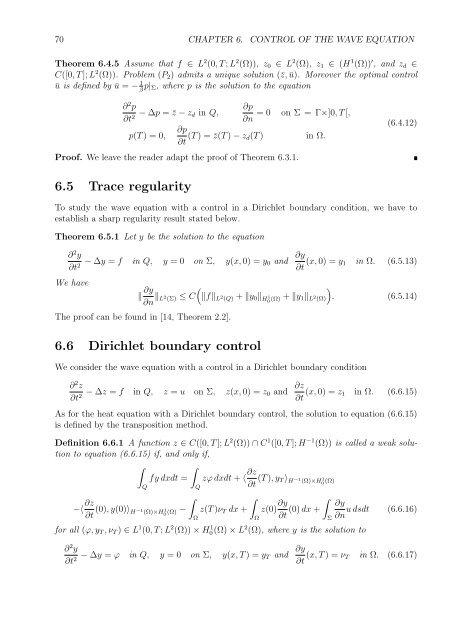Optimal Control of Partial Differential Equations
Optimal Control of Partial Differential Equations
Optimal Control of Partial Differential Equations
You also want an ePaper? Increase the reach of your titles
YUMPU automatically turns print PDFs into web optimized ePapers that Google loves.
70 CHAPTER 6. CONTROL OF THE WAVE EQUATION<br />
Theorem 6.4.5 Assume that f ∈ L 2 (0, T ; L 2 (Ω)), z0 ∈ L 2 (Ω), z1 ∈ (H 1 (Ω)) ′ , and zd ∈<br />
C([0, T ]; L 2 (Ω)). Problem (P2) admits a unique solution (¯z, ū). Moreover the optimal control<br />
ū is defined by ū = − 1<br />
β p|Σ, where p is the solution to the equation<br />
∂ 2 p<br />
∂t 2 − ∆p = ¯z − zd in Q,<br />
p(T ) = 0,<br />
∂p<br />
∂n<br />
= 0 on Σ = Γ×]0, T [,<br />
∂p<br />
∂t (T ) = ¯z(T ) − zd(T ) in Ω.<br />
Pro<strong>of</strong>. We leave the reader adapt the pro<strong>of</strong> <strong>of</strong> Theorem 6.3.1.<br />
6.5 Trace regularity<br />
(6.4.12)<br />
To study the wave equation with a control in a Dirichlet boundary condition, we have to<br />
establish a sharp regularity result stated below.<br />
Theorem 6.5.1 Let y be the solution to the equation<br />
∂2y ∂t2 − ∆y = f in Q, y = 0 on Σ, y(x, 0) = y0 and ∂y<br />
∂t (x, 0) = y1 in Ω. (6.5.13)<br />
We have<br />
∂y<br />
∂n L2 <br />
<br />
(Σ) ≤ C fL2 (Q) + y0H 1<br />
0 (Ω) + y1L2 (Ω) . (6.5.14)<br />
The pro<strong>of</strong> can be found in [14, Theorem 2.2].<br />
6.6 Dirichlet boundary control<br />
We consider the wave equation with a control in a Dirichlet boundary condition<br />
∂2z ∂t2 − ∆z = f in Q, z = u on Σ, z(x, 0) = z0 and ∂z<br />
∂t (x, 0) = z1 in Ω. (6.6.15)<br />
As for the heat equation with a Dirichlet boundary control, the solution to equation (6.6.15)<br />
is defined by the transposition method.<br />
Definition 6.6.1 A function z ∈ C([0, T ]; L2 (Ω)) ∩ C1 ([0, T ]; H−1 (Ω)) is called a weak solution<br />
to equation (6.6.15) if, and only if,<br />
<br />
<br />
fy dxdt =<br />
−〈 ∂z<br />
∂t (0), y(0)〉 H −1 (Ω)×H 1 0 (Ω) −<br />
Q<br />
<br />
Q<br />
Ω<br />
zϕ dxdt + 〈 ∂z<br />
∂t (T ), yT 〉 H −1 (Ω)×H 1 0 (Ω)<br />
<br />
z(T )νT dx +<br />
Ω<br />
z(0) ∂y<br />
<br />
∂y<br />
(0) dx + u dsdt (6.6.16)<br />
∂t Σ ∂n<br />
for all (ϕ, yT , νT ) ∈ L 1 (0, T ; L 2 (Ω)) × H 1 0(Ω) × L 2 (Ω), where y is the solution to<br />
∂ 2 y<br />
∂t 2 − ∆y = ϕ in Q, y = 0 on Σ, y(x, T ) = yT and ∂y<br />
∂t (x, T ) = νT in Ω. (6.6.17)

















